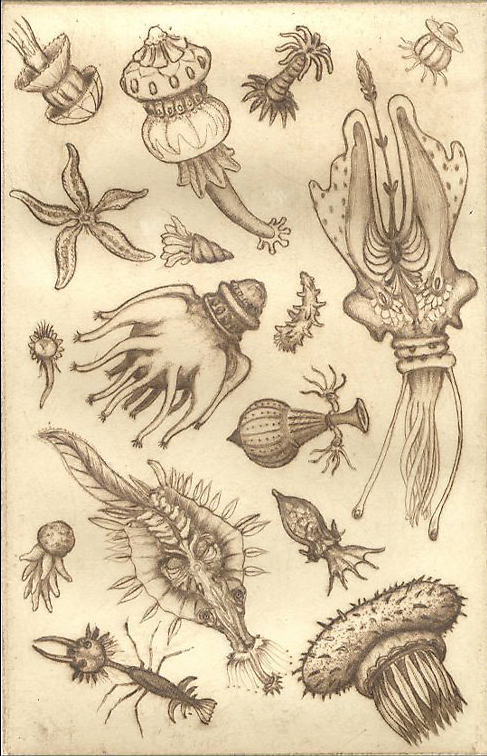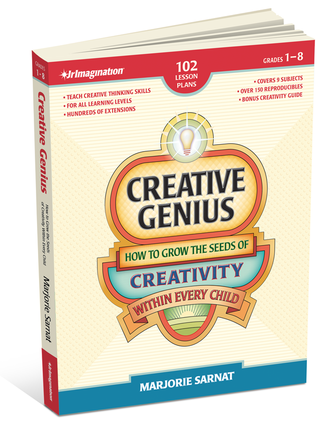What We Can Learn About Creativity This Flu Season
 Thursday, January 31, 2013 at 6:00PM |
Thursday, January 31, 2013 at 6:00PM |  Marjorie Sarnat
Marjorie Sarnat  Artist Brian McKenzie depicts amazing Animalcules that are his “purely imagined beings.” Image ©Brian McKenzie. All Rights Reserved. Used by permission.The holidays are over, but it’s still the season—of the flu.
Artist Brian McKenzie depicts amazing Animalcules that are his “purely imagined beings.” Image ©Brian McKenzie. All Rights Reserved. Used by permission.The holidays are over, but it’s still the season—of the flu.
After Jan. 1, “Season’s Greetings” takes on a whole other meaning, and not a friendly one either.
Our natural world provides us with endless beauty, from the grand mountains to perfect little rosebuds, from magnificent orca whales to exquisite little ladybugs.
Flu viruses are Mother Nature’s children, too. Yes, they’re nasty and we should avoid them as best we can, but in the spirit of creativity (flexibility of thought, open-mindedness, and seeing new perspectives) viruses, bacteria, and other microscopic creatures on Earth are visually aesthetic. There’s a whole life system we can’t see with our naked eyes but it’s as stunningly intricate and beautiful as anything else in our natural world.
Microscopic life was first discovered by Antony van Leeuwenhoek (1632-1723) in the mid 1600s. He called the organisms he saw “Animalcules.” His story is one of passion and the spirit of creativity.
Lens Maker, Scientist, Microbiologist
Antony van Leeuwenhoek, from Delft, Holland, was not likely to become a scientist. He had no fortune, no advanced education, and spoke no languages other than Dutch. This would normally have excluded him from the scientific community of the 1600s.
Yet he had skills, diligence, and a fervent curiosity. These, along with another important circumstance aided his success: it was his lack of advanced education that actually left his mind open to what he would discover, uninfluenced by the erroneous science assumptions of his era.
Having tried various trades, Leeuwenhoek eventually learned to grind lenses from glass. He discovered a way to make superior magnifying lenses through his own secret process using heated glass. His lenses were much more powerful than any others known. They magnified over 200 times, with clearer and brighter images than any others of his day.
What further distinguished Leeuwenhoek was his passion to observe anything that could be placed under his lenses, and his care in describing and illustrating the astonishing things he could see.
In 1683 Leeuwenhoek wrote the first descriptions of living bacteria ever recorded. Describing tooth plaque placed in a drop of rainwater: “I then saw, with great wonder... there were very many little living animalcules, very prettily a-moving... some a-swimming nimbly… all the water seemed to be alive…”
The Father Of Microbiology
 Leeuwenhoek observed animal and plant tissues, mineral crystals, and fossils. He was the first to discover blood cells, and varieties of microscopic animals, all of which he recorded in great detail. Leeuwenhoek’s writings were published and he became famous among scientific luminaries.
Leeuwenhoek observed animal and plant tissues, mineral crystals, and fossils. He was the first to discover blood cells, and varieties of microscopic animals, all of which he recorded in great detail. Leeuwenhoek’s writings were published and he became famous among scientific luminaries.
Antony van Leeuwenhoek’s knowledge of glassmaking allowed him to invent an advanced lens. Captivated by its powerful magnification, he then discovered nature’s hidden world, microbiology, which had never been known before. Leeuwenhoek created the foundation for modern medical research.
A Creative Hero
Antony van Leeuwenhoek exhibited the habits and methods of creative thinking in many ways.
- He asked “Why not?” He questioned established boundaries. He explored the outer limits of the most powerful lenses of his era. He also considered possibilities of life outside of what the scientists of the day believed to be true.
- He had personal courage. He was willing to stand alone in his beliefs, against the accepted, but erroneous, scientific assumptions of his day.
- He had fervent curiosity. He never stopped observing natural substances, such as lake water, and recorded his observations in great written detail with meticulous sketches. Here is part of his written description of green alga: “…I found floating therein divers, earthy particles, and some green streaks, spirally wound serpent-wise…consisting of very small green globules joined together…”
- He didn't give up. He was determined to make as fine and clear a magnifying lens as he could, eventually inventing a more powerful microscope than existed at that time. He continued to perfect his craft and offer his microscopic discoveries to the scientific community.
- He explored, investigated, and experimented. He engaged in the scientific method of trial and error and was not discouraged by failure. Through this method he taught himself to grind lenses finer than anyone else could do and to investigate the evidence of microscopic life. Leeuwenhoek's superior lenses led to his discovery of Nature's hidden secrets.
*
Creativity Sparkers For The Classroom Or Home
- Hands-on Experience: If you have access to a microscope, let kids look at prepared slides and other substances through it.
- Writing skills: Kids write detailed descriptions of what they view through the microscope, along with labeled sketches. Refer to Leeuwenhoek’s descriptions for examples.
- Science: Kids learn scientific facts about molecules, viral life, bacterial life, and other aspects of the microscopic world.
- Science Fiction: Kids use their knowledge as a foundation for creative writing and drawing. For example, kids can make up their own imaginary “Animalcules.” Name them, describe their anatomy, explain how they thrive, and draw them in detail, as well. Ask kids to mention at least two science facts in their descriptions, but let imaginations lead the way. (See Brian McKenzie's imaginary Animalcules at the top of this post. Visit Brian's website to see this and his other awesome artwork.)
- Artistic Expression: The microscopic world offers endless inspiration for the visual arts. Kids can create decorative surface patterns and abstract paintings by using microscopic imagery as reference.
*
One last thought: During this flu season, don’t forget to take your vitamins, especially Vitamin C—“C” for Creativity, that is.



